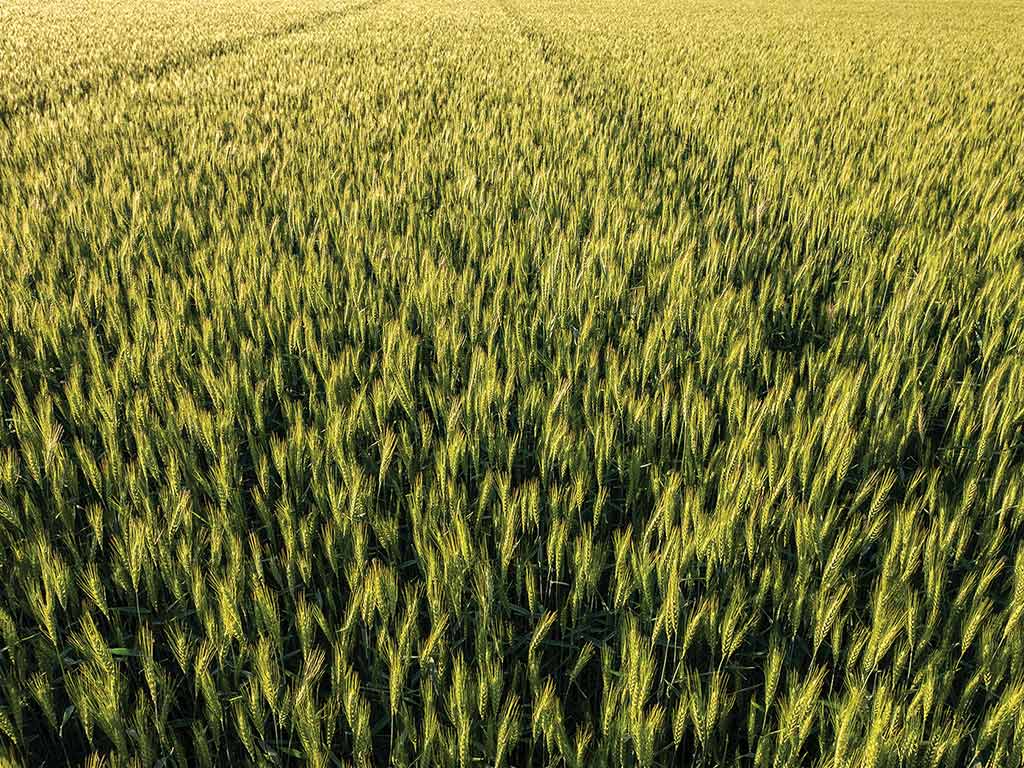Agriculture, Farm Operation April 01, 2025
Why Wheat Works
A cereal grain adds agronomic diversity to crop rotations.
by Bill Spiegel
After corn and soybean harvest each fall, the rolling landscape of northeast Kansas is dominated by browns and beiges.
On a few hundred acres near Winchester, however, patches of green stick out.
These are fields of winter wheat planted by farmer Alex Noll to add another revenue stream to his corn and soybean operation.
Prior to 2022, it had been a few decades since any wheat had been planted on the Noll farm. But that fall, it was dry and the market for soft wheat was strong.
"That fall was dry and the local soft wheat market was growing increasingly more appealing," Noll recalls. "We decided to put in 125 acres of wheat as a trial and await the outcome."
And it worked. In 2023, he won the Kansas winter wheat category of the National Wheat Yield Contest, harvesting 103.9 bushels per acre. In 2024, he did even better, reaping 133.10 bushels per acre to take the Kansas prize again.
Above. Bountiful heads of wheat from thick stands are key to growing high-yielding wheat, says Winchester, Kansas, farmer Alex Noll. He has earned top wheat yield honors in Kansas each of the last two years, and adds that wheat has a host of benefits in his corn/soybean crop rotation.
Many benefits. Economics aside, there are a lot of reasons to like what wheat brings to Noll's crop rotation.
Specifically, wheat breaks up weed cycles, affording the opportunity to use chemistries with a different mode of action. That's a big plus in boosting the efficacy of herbicides within his corn and soybean program.
Plus, Noll likes that wheat generates a lot of carbon.
"We're building organic carbon in the soil and improving organic matter. Soil health and soil biology revolve around that carbon," he adds.
A third benefit is the ability to plant double-crop soybeans into wheat stubble right after harvest, a practice that has produced soybean yields about 80% of his full-season soybeans, but saves at least one herbicide application. Three crops in two years is appealing, Noll says.
"If our wheat and double crop yields are similar to what they've been the last two years, I could see us expanding [our wheat acres] a little more," he says.
Noll appreciates the residue provided by the wheat/double crop soybean program, into which he plants corn.
In a report called "Beyond Grain," Luana Simão, a researcher at Kansas State University, cites Wisconsin research that shows corn and soybeans each had 5-8% yield bumps when following wheat; a 10-year study in Illinois found the same results.
Simão says yield of summer crops (corn, cotton, or soybeans) planted after wheat tend to increase, compared to summer crops planted consecutively.
"Those benefits are even more pronounced under water-limited conditions," she writes. Grain sorghum yields, for example, increased by nearly 30 bushels per acre when following a winter wheat crop compared to following grain sorghum or corn, according to a 20-year study in Tribune, Kansas.
Those yield improvements are associated with greater available water at planting for the summer crop, due to a few extra months of fallow period.
Winning agronomics. In his office, plaques commemorating yield contest wins for corn and soybeans line the wall. To Noll, raising wheat requires the same management principles used on corn: managing each plant, fine-tuning fertility, and protection from disease and weeds.
It begins with planting. Soft winter wheat is planted after corn harvest, at a rate of roughly 1.5 million seeds per acre; slightly more seeds if it is drier, or slightly less if planting conditions are ideal.
It's thicker than most agronomists recommend, but Noll reckons he'd rather have plenty of plants per acre so that each seed can produce a large seedhead.
Fertility is managed similarly to what he does with corn: multiple applications, timed to meet the crop's needs. "Any high-yielding corn guy will tell you not to put it all up front," he says.
A small portion of the total organophosphate nitrogen program is applied when the wheat is dormant; another at flag leaf and another at flowering. Foliar fungicide is added to each of those passes; the latter two also include a plant growth regulator.
The goal is to maximize output of each individual plant.
"I want every flag leaf to be the exact same height," Noll says. "It's no different than perfectly even-spaced emergence on a corn crop. I don't want any plants to compete." ‡
Read More

SPECIALTY/NICHE
Peony Pioneer
Bringing a niche ag industry to life in Alaska.

AGRICULTURE, LIVESTOCK/POULTRY
Masters of Marbling
Raising the bar on pork flavor and tenderness.



